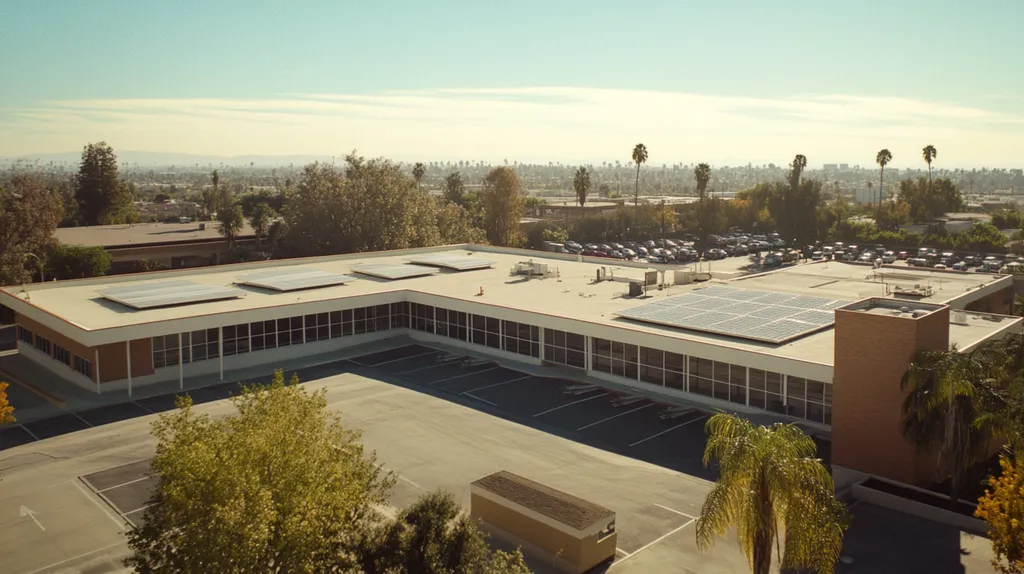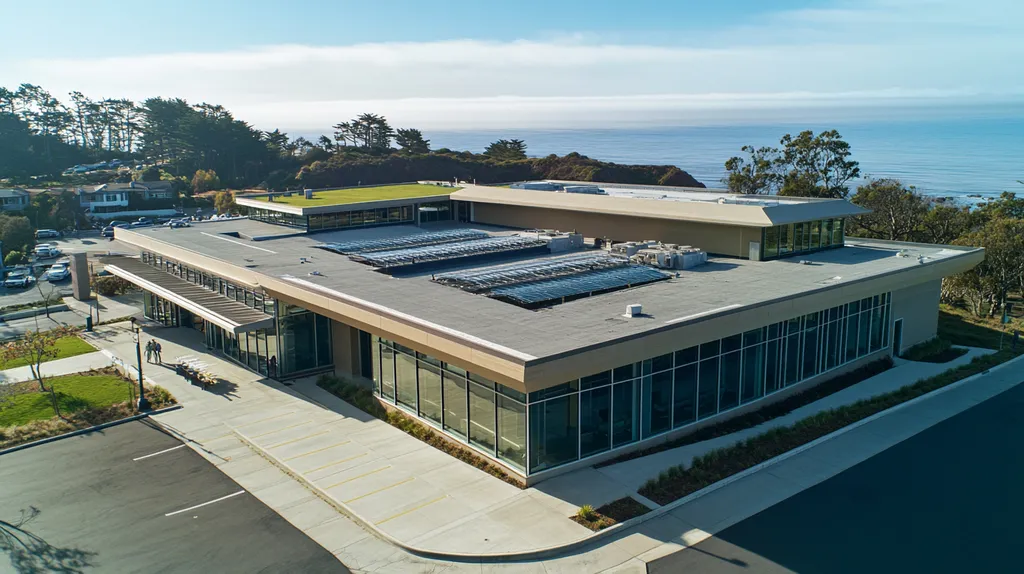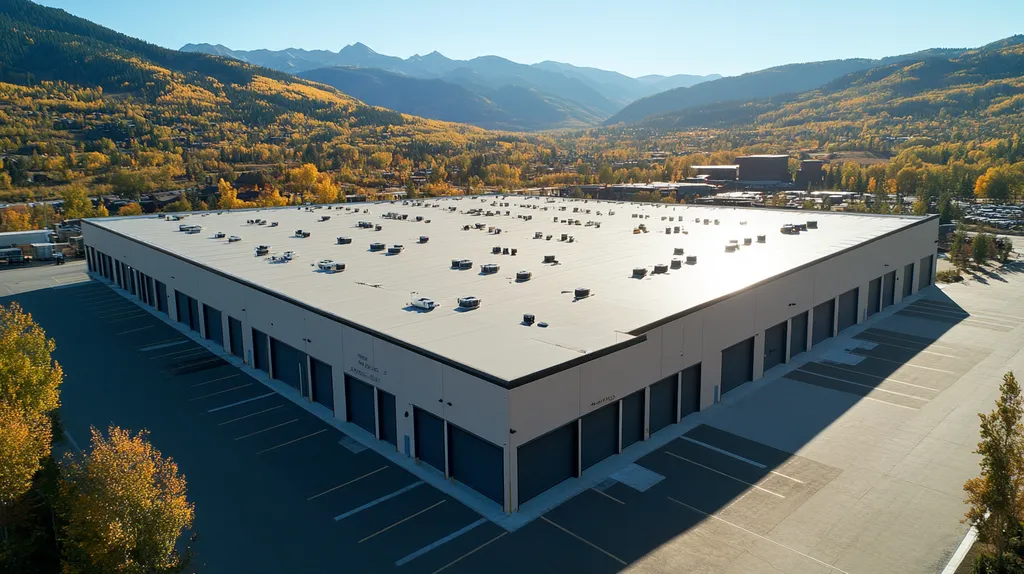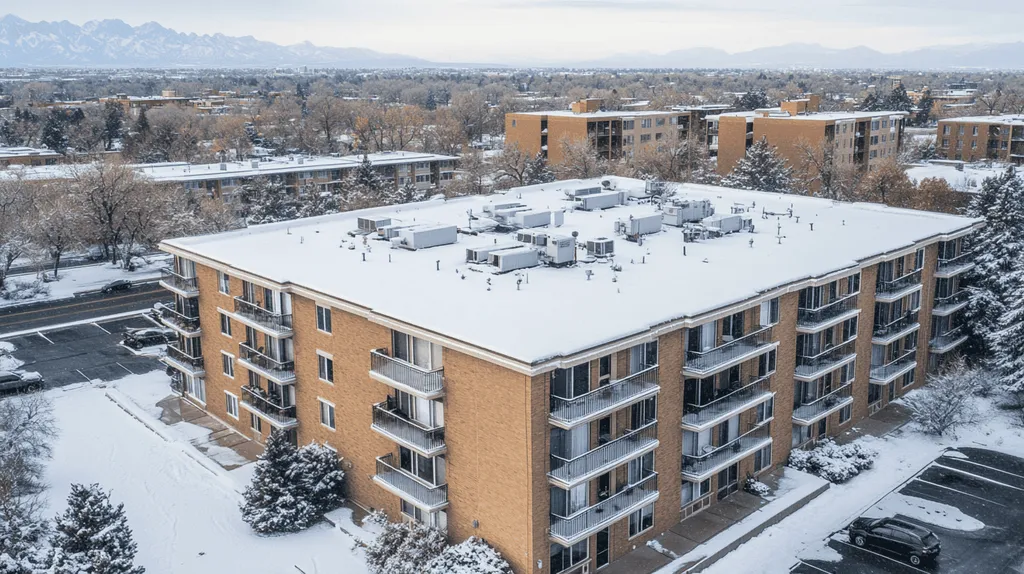The landscape of commercial roof ventilation has evolved dramatically since the days of simple turbine vents, yet dangerous myths persist among property owners and managers. Studies show that inadequate ventilation can increase cooling costs by up to 30% while accelerating structural deterioration.
From misconceptions about vent quantity to confusion between passive and active systems, these industry myths continue to drive costly mistakes in commercial properties across the nation.
This comprehensive analysis examines six key areas where ventilation misinformation impacts building performance, exploring evidence-based solutions that align with modern efficiency standards.
SECTION 1: COMMON MISCONCEPTIONS
The accuracy of commercial roof ventilation is vital, impacting not only the roof’s durability but also the energy efficiency of the entire building. Misunderstandings in this area can lead to expensive mistakes, such as increasing cooling costs by up to 30%. Therefore, it’s crucial to dispel the myths surrounding ventilation to facilitate sound decision-making. In this section, we will address misconceptions regarding the number of vents, the distinctions between passive and active ventilation systems, and the importance of strategic vent placement for optimal airflow.
Myth: More Vents Are Always Better
A widespread assumption is that adding more vents to a roof automatically enhances ventilation. While this may sound reasonable, it can often lead to complications. An excess of vents might disrupt natural airflow, creating stagnant zones where air fails to circulate effectively.
Furthermore, it’s the quality of the airflow that truly counts, not merely the quantity. Adequate air exchange is crucial for preventing moisture accumulation and maintaining optimal indoor air quality.
Additionally, too many vents can complicate roof maintenance and elevate the risk of leaks. Ultimately, this misconception can lead to increased long-term costs for property owners as they face damage repairs and less efficient energy usage.
A strategic and informed approach to vent installation is far more beneficial, prioritizing the right balance over sheer volume.
Misconceptions About Passive vs. Active Ventilation
Confusion frequently arises between passive and active ventilation systems. Many property owners mistakenly view passive systems as outdated or ineffective. This perspective is misleading.
In fact, passive ventilation capitalizes on natural air movement, efficiently regulating temperature and humidity without mechanical assistance. This method is often more cost-effective and energy-efficient, particularly in areas with mild temperature variations.
Active ventilation systems provide immediate control over airflow, but they tend to drive up energy expenses considerably. Property managers must carefully evaluate their unique requirements and local climate to select the most suitable option.
Failing to understand these distinctions can lead to inefficient HVAC operations, resulting in significant expenses over time.
Beliefs About Vent Placement and Airflow
There’s a common belief that where vents are placed is less important than how many are installed, with many assuming any location will suffice for effective airflow. This assumption is flawed, as vent placement has a direct correlation to the efficiency of the ventilation system.
Strategically positioning vents is essential to ensuring balanced airflow. Poorly chosen locations can create uncomfortable hot and cold spots, driving up energy costs and compromising comfort.
For instance, if exhaust vents are positioned too close to air intake sources, they may compete for airflow, diminishing overall effectiveness. Understanding airflow dynamics is crucial to optimizing vent placement.
Thoughtful planning can mitigate issues like condensation and moisture accumulation, both of which pose risks to the roof’s structural integrity. Thus, an educated and deliberate approach to vent placement is key to achieving a well-functioning ventilation system.
SECTION 2: PRACTICAL IMPLICATIONS
The choice to utilize fans for commercial roof ventilation is not just a preference; it’s a necessity for property owners and facility managers. Insufficient ventilation can lead to soaring attic temperatures, heightened humidity, and moisture-related challenges that jeopardize the integrity of the roofing structure. Research indicates that inadequate ventilation can increase roof temperatures by up to 20°F, which not only inflates energy costs but also accelerates structural degradation. By grasping these practical implications, decision-makers can make informed choices that enhance investments and ensure long-lasting roof performance.
Impact on Attic Temperature and Humidity
Insufficient roof ventilation can dramatically alter attic temperatures and humidity levels. When proper airflow is lacking, heat builds up in the attic, creating an environment ripe for mold growth and deterioration of materials. Elevated attic temperatures can accelerate wear on roofing components, necessitating earlier replacements than anticipated.
Moreover, high humidity can lead to condensation, fostering harmful mold and mildew that compromise indoor air quality. Effective roof ventilation plays a crucial role in regulating both temperature and humidity, which contributes to a healthier environment for all building occupants.
Data illustrates that a robust ventilation system can lower attic temperatures by as much as 10-25°F, significantly alleviating heat-related stress on the roofing materials. Property owners should recognize this connection to enhance the longevity of their roofs.
Additionally, a well-designed ventilation system promotes even air distribution, helping to minimize maintenance costs and ensuring reliability over time—benefits that directly support the overall efficiency of the facility.
Effects on Energy Efficiency and Costs
Understanding the link between roof ventilation and energy costs is essential. As attics heat up, cooling systems must compensate by working harder to keep indoor environments comfortable, leading to increased energy usage and rising utility bills.
Research suggests that effective ventilation can curtail cooling costs by 10-20%. For commercial properties, where energy expenditures form a significant part of operational budgets, these savings can be considerable.
Moreover, a well-ventilated roof reduces strain on HVAC systems, potentially extending their functional lifespan. This not only leads to fewer repairs and replacements but also translates into additional savings over the long term.
Investing in effective roof ventilation should be viewed as a strategic financial decision. Prioritizing proper ventilation equips property owners to achieve financial efficiency while fostering a sustainable operating environment.
Consequences for Structural Integrity
Maintaining structural integrity is paramount for any commercial roof. Excessive heat and humidity from insufficient ventilation can lead to a host of structural challenges, including warping, decay, and—at worst—complete system failure.
A frequent concern arises when roofing materials experience thermal cycling due to extreme heat fluctuations. These rapid temperature shifts can put undue stress on materials, resulting in cracks and leaks, which can escalate to catastrophic roof failures that disrupt business operations.
Additionally, trapped moisture can lead to rust and corrosion in metal components, undermining their structural strength. Property owners can face substantial repair costs and prolonged downtime if structural failings occur.
Thus, ensuring effective roof ventilation is vital not only for the health of individual components but also for the overall stability of the building. Prioritizing ventilation safeguards asset value and continuity in operations, highlighting its critical role in successful property management.
SECTION 3: COST OF MISINFORMATION
The financial repercussions of inadequate roof ventilation in commercial buildings are far-reaching and substantial. Property owners may find themselves facing costly repairs and rising energy bills due to misinformation. As roofs age, the absence of proper ventilation exacerbates these concerns, creating a chain reaction that affects all aspects of facility management. This section delves into the financial implications of misunderstandings surrounding roof ventilation, highlighting the importance of accurate information for making sound decisions.
Financial Consequences of Inadequate Ventilation
The financial toll of poor ventilation is often staggering. When moisture begins to accumulate on roofs due to insufficient airflow, it can result in severe water damage and compromise structural integrity. Repairing these issues can quickly escalate to tens of thousands of dollars.
Moreover, roofing materials may need to be replaced ahead of their expected lifespan, straining annual maintenance budgets further. Each unplanned expense underscores the critical need for clear guidance on ventilation practices.
Additionally, declining property values become a reality for owners who neglect ventilation concerns. Prospective buyers are typically wary of properties with known ventilation faults, limiting potential financial returns.
In essence, the misinformation surrounding ventilation directly threatens a facility’s financial stability, making informed education paramount.
Increased Maintenance and Repair Costs
Failing to ensure proper ventilation often accelerates the deterioration of roofing systems. Routine inspections may overlook hidden moisture problems caused by trapped air and humidity, leading to escalating repair demands.
This neglect can shift routine maintenance into the realm of emergency repairs, significantly inflating costs and diverting budget from other critical facility improvements.
Furthermore, the added maintenance burden may create reliance on contractors who charge higher fees for urgent work, perpetuating a cycle of drain on financial resources without addressing root issues.
In summary, the costs associated with inadequate ventilation extend beyond the roof, creating major budgetary strains that affect overall financial forecasts.
Potential for Energy Waste and Inefficiency
Inadequate roof ventilation directly contributes to energy inefficiencies, with trapped heat and moisture forcing HVAC systems into overdrive. This additional load translates to increased energy consumption and soaring utility bills.
Moreover, the environmental implications are significant, with higher energy usage contributing to a larger carbon footprint—counteracting many organizations’ sustainability efforts.
Thus, promoting clear communication about the necessity of effective roof ventilation is essential for fostering practices that lead to substantial energy savings and improved operational efficiency.
SECTION 4: REALITY CHECK
Effective ventilation is not just a minor detail; it is vital for extending the lifespan of commercial roofs. Inadequate airflow can lead to grave consequences, including moisture buildup, mold proliferation, and significant structural damage. The National Roofing Contractors Association (NRCA) points out that moisture-related issues are a leading cause of roofing failures. This section will focus on achieving balanced airflow between intake and exhaust vents, the critical roles of soffit and ridge vents, and the significance of vent size and airflow rates.
Balanced Airflow: Intake vs. Exhaust Vents
Achieving balanced airflow is essential for a roof’s ventilation system to function effectively. Intake and exhaust vents must work harmoniously to ensure that air circulates properly within the roofing structure. Without adequate intake vents to welcome fresh air, exhaust vents can become less efficient, resulting in stagnation and increased moisture levels.
For instance, if a building relies solely on exhaust vents, it can create negative pressure that pulls moisture-laden air from inside the structure. This situation not only worsens humidity issues but can also foster mold growth and decrease overall energy efficiency.
To implement an effective balance, property owners need to carefully plan the placement and quantity of both types of vents. When designed with intention, a balanced ventilation system can mitigate costly problems and extend the roof’s lifespan.
Regular inspections are also crucial. Over time, dirt, debris, and other blockages can hinder both intake and exhaust vents. Ensuring these components remain clean and functional is vital for maintaining overall roof health.
The Role of Soffit and Ridge Vents
Soffit and ridge vents are integral components of stack ventilation systems. Soffit vents, typically located beneath roof eaves, allow cooler air to flow into the attic space. Conversely, ridge vents are installed at the roof’s peak to facilitate the escape of warm, stale air.
When both types of vents operate in tandem, they create a seamless cycle of airflow. Warm air naturally rises, and by permitting it to escape through ridge vents, buildings can maintain a cooler environment. This is particularly critical during hot summer months, as trapped heat can significantly contribute to roof deterioration.
Additionally, soffit vents help prevent ice dam formation in colder climates by regulating attic temperatures. Ice dams can lead to serious roof damage if not addressed, creating potential for costly repairs.
To maximize their effectiveness, property owners should ensure that soffit and ridge vents are installed correctly and remain free from obstructions. Routine maintenance checks are essential for optimal operation.
Importance of Vent Size and Airflow Rates
The size of roof vents plays a vital role in achieving proper airflow rates. Vents that are too small cannot accommodate the necessary volume of air circulation, leading to inadequate ventilation. A benchmark is that one square foot of vent space is recommended for every 150 square feet of attic area.
If vents are undersized, it can lead to moisture and heat accumulation, accelerating the degradation of roofing materials. This deterioration compromises the roof’s integrity and results in unexpected repair costs.
To avert these issues, property owners should consult ventilation specialists during the design and installation phases. Utilizing tools like airflow calculators can aid in determining the appropriate size and number of vents needed for specific roofing systems.
Ultimately, ensuring that vents are sized correctly and airflow rates are adequate contributes to energy efficiency, enhances indoor air quality, and protects the overall integrity of the building. Investing in the right vent size is essential for the long-term performance and durability of the roof.
SECTION 5: EVIDENCE-BASED ALTERNATIVES
In the ongoing pursuit of effective commercial roof ventilation, property owners must navigate the critical issue of energy costs and air quality. Conventional methods often fall short, resulting in higher utility expenses and compromised indoor environments. To combat these challenges, property owners should explore innovative solutions that can enhance performance and sustainability. This section delves into the efficiencies of solar-powered ventilation systems, the benefits of energy recovery ventilators, and strategies tailored to optimize ventilation according to regional climate conditions.
Efficiency of Solar-Powered Ventilation Systems
Integrating solar-powered ventilation systems into commercial properties has become an urgent necessity. By harnessing the sun’s energy, these systems reduce reliance on conventional electricity, which can lead to remarkable cost savings. Once installed, a solar fan operates with virtually no energy expenditure for the facility.
Moreover, these systems align with sustainability goals, significantly lowering carbon footprints, a pressing request in today’s environmentally aware market. Property owners can take pride in demonstrating their commitment to the planet, which can bolster their brand image among consumers.
Maintenance for solar-powered systems is minimal in comparison to traditional electric fans. This aspect means fewer disruptions and prolonged durability, ensuring reliable operation throughout the year.
Ultimately, the advantages of solar-powered ventilation extend beyond cost efficiency; they signify a proactive approach to safeguarding commercial properties against future energy challenges.
Benefits of Energy Recovery Ventilators (ERVs)
Energy recovery ventilators (ERVs) emerge as a superior alternative for enhancing air quality and energy efficiency in commercial spaces. These advanced systems are engineered to capture and reuse energy from outgoing exhaust air, efficiently conditioning incoming fresh air. This process can dramatically reduce both heating and cooling demands.
For instance, an ERV can save up to 30% more energy compared to traditional ventilation approaches, making it a strategic investment for larger facilities. Furthermore, integrating ERVs can minimize the need for expansive HVAC systems, thereby simplifying operational processes.
In addition to energy savings, ERVs contribute to superior indoor air quality by filtering out harmful pollutants and optimizing humidity levels. Improved air circulation directly links to enhanced employee health and productivity, fostering a more favorable work environment.
In summary, adopting ERVs within commercial roofing strategies maximizes energy efficiency while significantly benefiting occupants, thus serving as a mutually advantageous solution for property managers.
Optimal Ventilation Strategies for Different Climates
Recognizing the influence of climate on ventilation strategies is essential for successful implementation. In warmer regions, combining passive ventilation techniques with roof fans can effectively reduce heat accumulation and promote air circulation, leading to a comfortable space with less dependency on air conditioning.
Conversely, in colder climates, it is critical to prevent heat loss while ensuring adequate fresh air intake. Well-designed mechanical ventilation systems can preserve energy efficiency, maintaining warmth in buildings during frigid months. Insulated ductwork also plays a crucial role in retaining warmed air.
Additionally, properties in humid areas must develop strategies to control moisture and curtail mold proliferation. Systems capable of swiftly expelling humid air are vital for sustaining the building’s integrity.
Ultimately, tailoring ventilation strategies to fit specific climate conditions enhances energy performance and contributes significantly to the longevity of the roofing system itself.
SECTION 6: TEST AND VERIFY
Ensuring proper ventilation is paramount to maintaining the longevity and functionality of commercial roofs. Without thorough testing and verification, roofing professionals expose themselves—and their clients—to the risks of moisture accumulation, insulation degradation, and heightened energy costs. Notably, the U.S. Department of Energy reports that inadequate ventilation can increase energy expenses by up to 30%. This section will delve into essential practices for assessing ductwork, evaluating ventilation performance, and conducting cost-benefit analyses to guarantee the effectiveness of roofing systems.
Conducting Ventilation Ductwork Inspections
Inspecting ventilation ductwork plays a crucial role in sustaining proper airflow within commercial buildings. Regular assessments can reveal blockages, leaks, or substandard installations that hinder system efficiency. Industry standards advocate for comprehensive inspections at least twice a year to identify potential issues before they escalate into costly problems.
During visual inspections, particular attention should be given to duct joints and connections, as these are common areas for air loss. Employing tools like infrared thermography can help pinpoint weaknesses that may escape the naked eye. Promptly addressing these findings is key for maintaining consistent ventilation performance and protecting the integrity of the roofing system.
Additionally, routine maintenance that includes cleaning and sealing ducts can greatly improve airflow and enhance environmental control. Ensuring unobstructed functioning of ventilation systems is integral to managing energy utilization and overall operational expenditures.
In essence, effective ductwork inspections lay the groundwork for improved energy efficiency and a prolonged lifespan for roofing structures.
Evaluating Ventilation Rates and Performance
Assessing ventilation rates is essential for understanding how effectively a building handles air exchange. Facility managers should utilize instruments like anemometers or airflow hoods to measure the actual airflow against the desired rates. Such evaluations are vital for identifying fluctuations that may impact climate control within the building.
Adhering to industry best practices, all ventilation systems should meet ASHRAE 62.1 guidelines, which define the minimum ventilation rates necessary for various building types. By aligning with these standards, property owners can cultivate healthier indoor environments while optimizing energy usage.
Moreover, evaluations should encompass how ductwork design affects airflow. Long or convoluted ducts may create additional resistance, undermining efficiency. Analyzing these design elements enables more informed adjustments, ensuring that every component serves the broader ventilation strategy effectively.
Regularly reviewing ventilation rates empowers building owners to enact data-driven enhancements, ultimately leading to both cost savings and greater comfort for occupants.
Using Cost-Benefit Analysis for Ventilation Systems
Implementing a cost-benefit analysis for ventilation systems provides a structured method to evaluate investments in operational efficiency. This analysis juxtaposes initial installation costs with the long-term savings on energy and maintenance. Effective ventilation can reduce heating and cooling costs by up to 20%, yielding substantial savings over time.
Additionally, assessing factors like diminished equipment wear and enhanced durability of roofing materials further justifies the rationale for investing in superior ventilation systems. Facilities managers should recognize these long-term effects, as they contribute to improved budgeting and sustainability initiatives.
It is essential to consider the total cost of ownership rather than merely upfront expenditures. Decisions should incorporate the potential preventive measures against water damage or structural failures, which can result in hefty repair bills. A comprehensive analysis fosters smarter investments that preserve the building’s value.
By adopting detailed cost-benefit evaluations, property owners can take a more strategic approach to managing their ventilation systems, ensuring both financial prudence and operational effectiveness.
Looking Ahead
As commercial roofing technology advances, the cost of ventilation mistakes grows exponentially, with industry data showing inadequate systems can reduce roof lifespans by up to 25% while increasing energy costs by 30%.
The persistence of outdated ventilation myths continues to drive costly decisions across the commercial sector, resulting in millions in preventable damage annually.
Property owners who embrace evidence-based ventilation strategies – from balanced intake/exhaust systems to climate-optimized solutions – position themselves to realize significant returns through reduced maintenance costs and enhanced energy efficiency.
The future of commercial roof performance hinges on displacing harmful misconceptions with proven ventilation practices that protect both structural integrity and bottom-line results.
FREQUENTLY ASKED QUESTIONS
Q. Is it true that more vents always mean better commercial roof ventilation?
A. More vents can disrupt airflow dynamics. It’s essential to focus on quality airflow management instead of just quantity. Poor ventilation from excess vents can lead to moisture issues and unexpected energy costs.
Q. How does poor ventilation affect the temperature of my commercial roof?
A. Without proper roof ventilation, attic temperatures can rise significantly, leading to potential mold growth and material degradation. A robust ventilation system can help maintain lower temperatures, preserving your roof’s integrity.
Q. What are the financial risks of misinformation regarding industrial roof ventilation?
A. Misunderstandings about ventilation can result in costly repairs and increased energy expenses. When ventilation is neglected, it can lead to serious damage to roofing systems, necessitating significant financial investment for repairs.
Q. Why is balanced airflow critical for commercial roofs?
A. Proper balance between intake and exhaust vents ensures optimal airflow, preventing stagnation and moisture accumulation. This balance is vital for maintaining air quality and prolonging the lifespan of the roofing structure.
Q. How can solar-powered ventilation systems benefit commercial buildings?
A. Solar-powered systems provide significant energy savings by using renewable energy. They reduce electricity reliance and align with sustainability goals, all while minimizing maintenance efforts and maximizing ventilation efficiency.
Q. What should I monitor during ductwork inspections for my commercial roof?
A. During ductwork inspections, focus on blockages, leaks, and subpar installations. Regular assessments help maintain efficient airflow and protect your roofing structure from long-term damage and energy inefficiencies.
Q. How can I choose the right ventilation system for my industrial roof?
A. Evaluate your specific needs based on building size, climate, and usage. Consulting with a ventilation specialist can provide tailored solutions that enhance performance and longevity for your roofing system.











